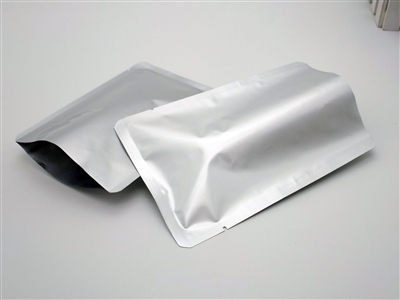
Aluminum foil bag is a common packaging form in the market, with good sealing, puncture resistance, fragrance and other characteristics, favored by consumers. However, for a long time, as a boiling bag of aluminum foil packaging, more or less in the boiling will appear in the phenomenon of "rotten aluminum" : that is, from the appearance of the bag, the surface of the black, white ink is particularly obvious. When observed through light, it will be found that the VMPET aluminum plating layer disappears and becomes transparent.
What causes the VMPET aluminum coating to disappear or partially disappear?
1. Reason analysis
Chemical reaction: Aluminum is a reactive metal that reacts easily with acidic or alkaline substances. PET is a polymer compound (polyethylene terephthalate glycol ester), is two completely different substances, in the absence of a binder, by vaporization, condensation method to combine the two. If the food in the package contains acidic or alkaline ingredients, or the package is exposed to these substances during the production and storage process, it will lose the brightness of the aluminized layer, thus showing the phenomenon of "aluminum decay".
Electrochemical corrosion: In humid environments, aluminum may form galvanic cells with other metals, leading to electrochemical corrosion. For example, if the aluminum layer is in contact with other metals (such as iron, copper) and electrolytes (such as water) are present, electrochemical corrosion may occur.
Packaging material problems: If the quality of the packaging material is not qualified, such as insufficient thickness of the aluminum layer, uneven coating or defects, it may cause the aluminum layer to be more susceptible to corrosion.
Production process problems: From the structural observation, the aluminum plating layer is directly in contact with the adhesive and indirectly in contact with the ink, and the outer layer of the ink is PET film. When boiling, the water vapor can react with the aluminized layer through the PET film, ink layer and adhesive layer from the outer layer to produce aluminized phenomenon. In the production process of packaging, if the cleaning, coating, sealing and other processes are not properly controlled, it may also lead to aluminum layer corrosion.
Storage and transportation conditions: If the packaging is exposed to humidity, high temperature or corrosive gases during storage and transportation, the corrosion of the aluminum layer may be accelerated.
Second, process control ideas
Through the experiment, it is found that the necessary condition to cause the rotting aluminum is that there is water involved in the reaction, and water reacts with the aluminum plating layer. In the parts with ink printing, the combination between PET and VMPET is more loose than that in the parts without ink printing, water vapor is easier to pass through, the composite strength of perishable aluminum products is relatively low (below 1N/mm), and the composite strength of non-perishable aluminum products is relatively high. The use of different manufacturers of glue, the degree of corrosion aluminum is also different. The lower the composite strength, the easier it is to produce rotten aluminum. The quality of aluminum plating film has a great influence on the condition of aluminum decay.
Therefore, the essential reason for the generation of rotten aluminum is the reaction of water vapor through the PET layer and the aluminized layer. The peeling strength of the adhesive used determines the severity of the rotting aluminum: the higher the peeling strength, the stronger the adhesive ability; The denser the structure of the adhesive, the better the barrier, the lower the probability of water vapor passing through the glue, and it is not easy to produce dissolved aluminum. On the contrary, it is easy to produce dissolved aluminum. Therefore, in order to avoid aluminum decay, it is recommended that enterprises use enhanced aluminized adhesive products when producing boiled structure PET//VMPET//PE.
In short, if there is "rotten aluminum" in the boiled package, it will not only affect the appearance and performance of the package, but also may pollute the food in the package and affect food safety. Therefore, manufacturers need to strictly control the quality of packaging materials, optimize the production process, and ensure that packaging is stored and transported in a suitable environment to prevent the occurrence of aluminum layer corrosion. At the same time, when buying and using such packaging, consumers should also pay attention to check the integrity of the packaging and whether there are signs of corrosion.